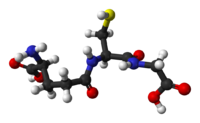
Photo from wikipedia
Abstract A novel electrochemical sensor based on ethyl 2-(4-ferrocenyl-[1,2,3]triazol-1-yl) acetate (EFTA) and graphene has been developed for electrocatalytic oxidation and determination of cysteine. The electrochemical behavior of cysteine at the… Click to show full abstract
Abstract A novel electrochemical sensor based on ethyl 2-(4-ferrocenyl-[1,2,3]triazol-1-yl) acetate (EFTA) and graphene has been developed for electrocatalytic oxidation and determination of cysteine. The electrochemical behavior of cysteine at the EFTAGCPE was investigated by voltammetric techniques. The EFTAGCPE showed efficient electrocatalytic activity for the oxidation of cysteine in 0.1 M phosphate buffer solution (pH 7.0). The oxidation overpotential of cysteine decreased significantly compared with the bare electrode and its oxidation peak currents increased dramatically at EFTAGCPE. The potential utility of the sensor was demonstrated by applying it to the analytical determination of cysteine concentration. The results showed that the electrocatalytic current increased linearly with the cysteine concentration in the range of 4.0–2300.0 μM and the detection limit was 0.9 μM. Also the prepared modified electrode exhibits a very good resolution between the voltammetric peaks of cysteine and tyrosine. The sensor was applied to determine cysteine and tyrosine in human fluids samples.
Journal Title: Measurement
Year Published: 2020
Link to full text (if available)
Share on Social Media: Sign Up to like & get
recommendations!